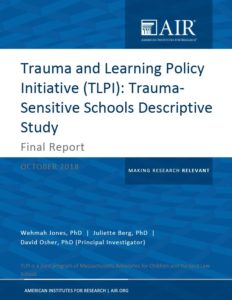QUESTION 2:How do we know we are ready to create a Trauma-Sensitive Action Plan?
Schools address this question by engaging in the following activities:
1. Engaging the whole staff in deepening their shared understanding of the impacts of traumatic experience
BLOG:
 Our work has shown us that schools that can articulate why they are ready and can identify the priorities that are the catalyst for their decision to undertake the work of becoming trauma sensitive are much more likely to have success with it taking hold.
Our work has shown us that schools that can articulate why they are ready and can identify the priorities that are the catalyst for their decision to undertake the work of becoming trauma sensitive are much more likely to have success with it taking hold.
One way to go about building consensus is by sharing information to deepen staff’s understanding of the impacts of trauma on learning, behavior, relationships and student well-being. There are a variety of ways to go about learning together to develop a coalition within the school.
2. Surveying all of the staff
(for survey questions, see page 47 HTCL, Vol 2)
It is crucial to elicit staff’s reaction after they have been given time to learn together about the prevalence of trauma and its impacts, the need for trauma-sensitive schools and the importance of a school wide approach. This survey is designed to be administered to ALL staff at the conclusion of their professional development on these topics.
BLOG:
 The process of creating a trauma-sensitive school begins when an individual’s or small group of staff have a sense of urgency about the need to address an important school priority. When a significant number of staff determine to address this urgent priority in a trauma-sensitive way the seed for making change can take hold. Often through discussions or through a process of reflection among school staff, an awareness of urgent priorities emerges.
The process of creating a trauma-sensitive school begins when an individual’s or small group of staff have a sense of urgency about the need to address an important school priority. When a significant number of staff determine to address this urgent priority in a trauma-sensitive way the seed for making change can take hold. Often through discussions or through a process of reflection among school staff, an awareness of urgent priorities emerges.
BLOG:
 We recently shared with you the TLPI Trauma-Sensitive Schools Descriptive Study conducted by researchers from the American Institutes For Research (AIR). This month’s blog post explores one of the key findings of the report related to readiness or the extent to which the school is both willing and able to undertake the process of becoming trauma sensitive, safe and supportive. Readiness (or lack of) influences how well a new effort will take hold and be sustained. When readiness is high, the organization is better able to initiate and sustain a major change. Taking the time to evaluate and build readiness was found to be a key implementation factor in creating a trauma-sensitive school.
We recently shared with you the TLPI Trauma-Sensitive Schools Descriptive Study conducted by researchers from the American Institutes For Research (AIR). This month’s blog post explores one of the key findings of the report related to readiness or the extent to which the school is both willing and able to undertake the process of becoming trauma sensitive, safe and supportive. Readiness (or lack of) influences how well a new effort will take hold and be sustained. When readiness is high, the organization is better able to initiate and sustain a major change. Taking the time to evaluate and build readiness was found to be a key implementation factor in creating a trauma-sensitive school.
Part 3: Visions of a Trauma-Sensitive School Questions
Question 1: Why do we feel an urgency to become a trauma-sensitive school?
Question 2: How do we know we are ready to create a Trauma-Sensitive Action Plan?
Question 3: What actions will address staff priorities and help us become a Trauma-Sensitive School?
Question 4: How do we know we are becoming a Trauma-Sensitive School?